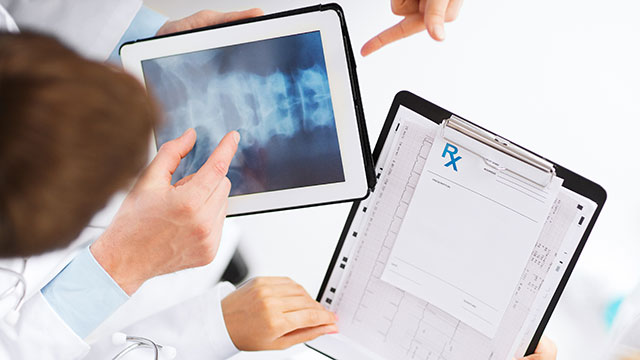 Lev Dolgachov/PhotoSpin
Lev Dolgachov/PhotoSpin
Technology is transforming the way people handle their healthcare and it’s not slowing down. Check out these innovative technologies currently available or about to hit the market.
1) Wearable Technology
Wearable technologies are becoming common tools both patients and doctors can use to monitor health. OMsignal, a smart clothes company, creates apparel that helps measure information like heart rate and calories burned to improve health and wellness. The clothing is unobtrusive and uses biosensors to track health data. In June 2013, Dr. Rafael Grossman became the first surgeon to use Google Glass in the operating room. Grossman recorded his medical procedure with the device and hopes to use wearable technologies such as Google Glass as a way to educate medical students through video footage. As Google Glass becomes more available, more medical workers are using the technology.
2) 3D Printing
The health industry is beginning to use 3D printers to study diseases and improve health for patients. A lab at Heriot-Watt University in Edinburgh used a 3D printer to produce embryonic stem cells. The researchers hope to use the cells to grow tissue and new organs. 3D printing has also created skin to care for burn victims, blood vessels and cardiac tissue to model a heart, and cancer cells to study the disease and work toward a cure, according to an article on referral MD.
3)MelaFind
MelaFind is a piece of technology that scans below the skin’s surface for signs of melanoma. The device helps dermatologists and other doctors decide whether their patient should go through with a biopsy. MelaFind’s main goal is to reduce the number of unnecessary biopsies by verifying if the procedure is needed.
4) Robotic Check-Ups
Medical robots are changing the way doctors check on patients in hospitals. The RP-Vita Remote Presence Robot improves medical workflows by traveling through and patrolling hospital hallways, visiting different patients, and monitoring patients’ vital signs, an article by ASME said. The device also features a two-way video screen that helps provide team-based care for patients. Through it’s screen, RP-Vita invites multiple doctors to interact with a patient while a nurse is available in person.
5) Optogenetics
Optogenetics is used by neuroscientists to study brain activity. By targeting a single neuron within the brain, they can research mental diseases such as depression and schizophrenia, as well as better understand why humans think and act they way they do. So far optogenetics has only been used on rats, but if effective, it may be used on the human brain.
6) Needle-free Vaccinations
Thanks to funding from the Bill and Melinda Gates Foundation, needle-free vaccinations may be making their way into the healthcare industry soon. Currently researchers at King’s College London are developing a method to give vaccines without a needle. Needle-free vaccinations are comprised of a dried live vaccine that is molded into a microneedle array, according to Healthline. The microneedles are shaped as a small disc and the vaccination dissolves into skin, treating patients.
7) Augmented Nutrition
Several mobile apps exist that help track calories, but augmented nutrition helps personalize healthy eating even more. The AIRO wristband features a built-in spectrometer that measures nutrients in the bloodstream after eating meals, counts calories and evaluates the healthiness of foods, according to Mashable. The device launches in fall 2014 and also looks at sleep patterns, stress levels and exercise.
8) Digestible Sensors
Digestible sensors are placed in pills and provide doctors with information about the health of their patients. According to a referral MD article, the sensors study different organs and systems within the human body, then report back data that can be looked at on a computer or smartphone. Digestible sensors can also detect diseases in early stages and help doctors customize treatments for patients.
9) Virtual House Calls
Virtual house calls bring medical experts directly to patients, without having to go to the hospital. Talk To Docs, a mobile app by HealthTap, lets users type or ask a health question among a network of more than 50,000 U.S.-licensed doctors. The app provides immediate answers and tips that are personalized to each specific question. LiveHealth Online is another service that lets patients speak with doctors from their home. Once users set up an account, they can search doctors by state and video chat with them.
10) Heart Valve Technology
When patients with heart problems don’t undergo open-heart surgery heart valve technology is a great option. The Edwards SAPIEN Transcatheter Heart Valve is one type of heart valve technology. The device is inserted through an artery and replaces the damaged heart valve, allowing the heart to function properly again.
11) Miniaturized Blood Tests
Theranos, based out of Palo Alto, is a health company working on transforming lab testing. The company uses miniaturized blood tests, which allow them to analyze patients with as little as a single drop of blood. Rather than using a large needle, the company uses a small finger stick to collect a blood sample to analyze.
Visit https://www.empowher.com/wellness/healthy-technology to learn more about healthy technologies.
Resources
3D-Printed Human Embryonic Stem Cells Created for First Time. LiveScience. Retrieved May 18, 2014. http://www.livescience.com/26865-3d-printed-embryonic-stem-cells.html
5 Health Tech Trends to Watch in 2014. Mashable. Retrieved May 18, 2014. http://mashable.com/2013/12/09/health-tech-trends-2014/
10 Top Medical and Technological Innovations of 2013. Healthline. Retrieved May 18, 2014. http://www.healthline.com/health-news/general-top-innovations-of-2013-12...
RP-VITA Remote Presence Robot. InTouch Health. Retrieved May 18, 2014. http://www.intouchhealth.com/products-and-services/products/rp-vita-robot/
The 7 Biggest Innovations in Health Care Technology in 2014 [INFOGRAPHIC]. Referral MD. Retrieved May 18, 2014. http://getreferralmd.com/2013/11/health-care-technology-innovations-2013...
Top 5 Medical Technology Innovations. ASME. Retrieved May 18, 2014. https://www.asme.org/engineering-topics/articles/bioengineering/top-5-me...





Add a CommentComments
There are no comments yet. Be the first one and get the conversation started!